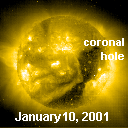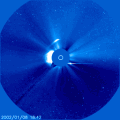|   SPACE WEATHER SPACE WEATHER
Current
Conditions
Solar Wind
velocity: 605.2 km/s
density:3.3 protons/cm3
explanation | more data
Updated: Today at 2245 UT
X-ray Solar Flares
6-hr max: C3 2035 UT Jan10
24-hr: C6 1015 UT Jan10
explanation | more data
Updated: Today at 2245 UT
Daily Sun: 10 Jan '02 
Fast-growing active region 9773 has developed a delta-class magnetic field that harbors energy for X-class solar flares. Image credit: SOHO/MDI
The Far Side of the Sun

This holographic image reveals a smattering of spots on the far side of the Sun. Image credit: SOHO/MDI
Sunspot Number: 159
More about sunspots
Updated: 09 Jan 2002
Radio Meteor Rate
24 hr max: 10 per hr
Listen to the Meteor Radar!
Updated: 08 Jan 2002 Interplanetary Mag. Field
Btotal: 19.8 nT
Bz: 2.6 nT south
explanation | more data
Updated: Today at 2246 UT Coronal Holes:

Solar wind gusts flowing from the indicated coronal hole will soon buffet Earth's magnetosphere. Image credit: SOHO Extreme UV Telescope.
More about coronal holes
 SPACE WEATHER SPACE WEATHER
NOAA
Forecasts
Solar Flares: Probabilities for a medium-sized (M-class) or a major (X-class) solar flare during the next 24/48 hours are tabulated below.
Updated at 2002 Jan 10 2200 UT
| FLARE | 0-24 hr | 24-48 hr | | CLASS M | 75 % | 75 % | | CLASS X | 25 % | 25 % |
Geomagnetic Storms: Probabilities for significant disturbances in Earth's magnetic field are given for three activity levels: active, minor storm, severe storm
Updated at 2002 Jan 10 2200 UT Mid-latitudes | 0-24 hr | 24-48 hr | | ACTIVE | 50 % | 50 % | | MINOR | 30 % | 30 % | | SEVERE | 10 % | 10 % |
High latitudes | 0-24 hr | 24-48 hr | | ACTIVE | 30 % | 40 % | | MINOR | 50 % | 40 % | | SEVERE | 10 % | 10 % |

Web server provided by
VPS Hosting | What's Up in Space -- 10 Jan 2002
Subscribe to Space Weather News! AURORA WATCH: Our planet is entering a high-speed solar wind stream flowing from a coronal hole on the Sun. High-latitude sky watchers should be alert for auroras tonight, especially during the hours around local midnight. SOLAR FLARE: Twisted magnetic fields near fast-growing sunspot 9773 erupted on Jan. 9th and sparked an M9.5-class solar flare at 18:01 UT. The explosion did not hurl a coronal mass ejection toward Earth. 
Above: This 7-day SOHO animation spanning Jan. 4th-10th highlights the impressive growth of sunspot 9773. COMET MOVIES: Watch Comet Machholz's close encounter with the Sun in these 3-day SOHO animations: small (0.32 MB), medium (0.85 MB), large (1.6 MB). Read on for more information...  SPECTACULAR: A brilliant coronal mass ejection (CME) billowed away from the Sun on January 8th just as periodic comet 96P/Machholz was swinging by our star. Coronagraphs on board the SOHO spacecraft captured both in this 8-hour movie (right). SPECTACULAR: A brilliant coronal mass ejection (CME) billowed away from the Sun on January 8th just as periodic comet 96P/Machholz was swinging by our star. Coronagraphs on board the SOHO spacecraft captured both in this 8-hour movie (right).
Although the CME appears to envelop the comet, it did not. The expanding cloud raced away from the backside of the Sun. Both the comet and our planet were in the other direction. Comet Machholz was only 0.12 AU from the Sun on Jan. 8th when it reached perihelion (closest approach to the Sun). Our star's blinding glare hid the encounter from human eyes, but not from SOHO coronagraphs, which use opaque disks to block the Sun's light. Unlike many Sun-approaching comets, notably the "Kreutz sungrazers," 96P/Machholz survived its fiery experience and will return again in 2007. SOUTHERN COMET: Comet C/2000 WM1 (LINEAR) is heading for the Sun; at closest approach on Jan. 22nd it will lie 0.55 AU from our star. The encounter won't be as dramatic as Comet Machholz's, but it will be pleasing for southern hemisphere sky watchers who can see the 5th magnitude comet with binoculars or -- just barely -- with the unaided eye. Pictured below is Comet LINEAR on Jan. 8th, photographed by Victor Angel Buso, Mariano Ascheri, Gustavo Mazalan and Luis Alberto Mansilla in Argentina. [photo details]  WEB LINKS: NOAA FORECAST | GLOSSARY | SPACE WEATHER TUTORIAL | LESSON PLANS | BECOME A SUBSCRIBER | 
Potentially Hazardous Asteroids (PHAs) are space rocks larger than approximately 100m that can come closer to Earth than 0.05 AU. None of the known PHAs are on a collision course with our planet, although astronomers are finding new ones all the time.
On 10 Jan 2002 there were 367 known Potentially
Hazardous Asteroids Jan. 2002 Earth-asteroid encountersNotes: LD is a "Lunar Distance." 1 LD = 384,401 km, the distance between Earth and the Moon. 1 LD also equals 0.00256 AU. MAG is the visual magnitude of the asteroid on the date of closest approach. 
- ASTEROID FLYBY: Asteroid 2001 YB5 raced past Earth on Jan. 7, 2002, only two times farther away than the Moon. [gallery]
- SUBTLE ECLIPSE: The Moon dipped into the outskirts of Earth's shadow on Dec. 30, 2001. [gallery]
- MOON & SATURN: The Moon keeps getting in the way of Saturn! See the series of close encounters here.
- CHRISTMAS LIGHTS: On Christmas Eve, 2001, a solar wind stream triggered Northern Lights. [gallery]
- SOLAR ECLIPSE: Sky watchers in Hawaii and most parts of North America experienced a partial solar eclipse on Dec. 14th. [gallery]
- BRIGHT ASTEROID: Videos and images of 1998 WT24 -- a big and bright near-Earth asteroid that came close to our planet on Dec. 16, 2001. [gallery]
- NORTHERN LIGHTS: On Nov. 24th a pair of coronal mass ejections swept past Earth and triggered worldwide auroras.
- LEONIDS 2001: Some people saw it. Others heard it. In either case, they'll never forget it: The 2001 Leonid meteor storm.
- PERSEIDS 2001: Perseid watchers on August 12th spotted meteors, auroras, and a disintegrating Russian rocket! [gallery]
- MORNING PLANETS: In July and Aug. 2001, the Moon, Jupiter, Saturn, Venus, and Mercury put on a dazzling early-morning sky show. [gallery]
- ECLIPSE SAFARI: Onlookers cried out in delight on June 21, 2001, when the Moon covered the African Sun, revealing the dazzling corona. [gallery]
- TOTAL LUNAR ECLIPSE: On Jan. 9, 2001, the full Moon glided through Earth's copper-colored shadow. [gallery]
- CHRISTMAS ECLIPSE: Sky watchers across North America enjoyed a partial solar eclipse on Christmas Day 2000 [gallery]
- LEONIDS 2000: Observers around the globe enjoyed three predicted episodes of shooting stars. [gallery]
 Nov. 7 , 2001: What Lies beneath a Sunspot -- Awesome plasma hurricanes were one of the surprises revealed when scientists peered beneath the stormy surface of our star. Oct. 26 , 2001: 'tis the Season for Auroras -- Autumn is a good time to spot Northern Lights. Oct. 17, 2001: Halley's Comet Returns ... in bits and pieces -- The annual Orionid meteor shower peaks on October 21st. Aug. 9, 2001: Horse Flies and Meteors -- Like bugs streaking down the side window of a moving car, long and colorful Perseid Earthgrazers could put on a remarkable show on August 11th. July 27, 2001: Meteorites Don't Pop Corn -- A fireball that dazzled Americans on July 23rd probably didn't scorch any cornfields, contrary to widespread reports. June 12, 2001: The Biggest Explosions in the Solar System -- NASA's HESSI spacecraft aims to unravel an explosive mystery: the origin of solar flares. |

